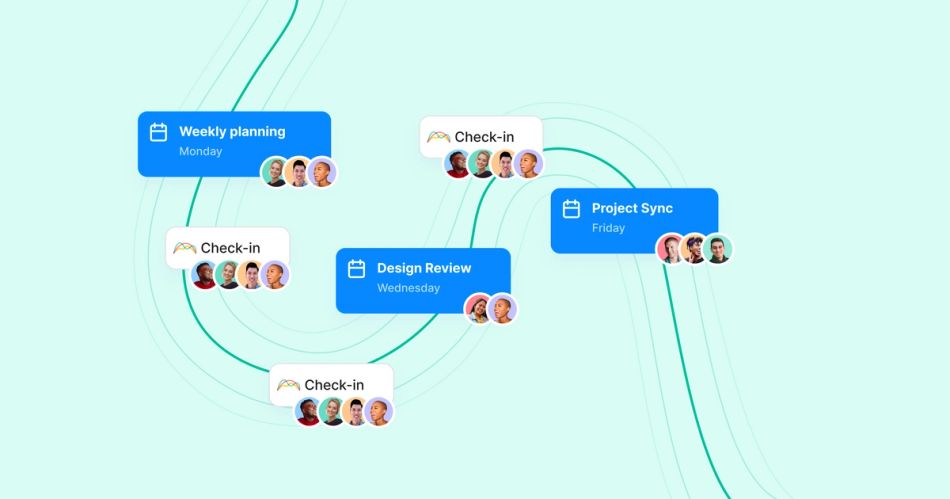
The daily standup is a powerful tool used by teams to move projects forward. Born out of the agile development process, standups are now used by all sorts of teams — not just engineering — as a way to check-in and tackle work together.
In theory, effective daily standups are short and sweet. Fifteen minutes to come together each morning to align, unblock, and set each other up for success that day.
In reality though, most tend to morph into something very different. They may become unwieldy and ineffective, distracting and draining, or simply a poor use of the whole team’s time.
💸 How much $$$ could you save with async standups?
⚡️ Try the Standup Cost Calculator.
For today’s remote and hybrid teams, balancing timezones and schedules adds another layer of complexity to the mix.
No matter where you work, teams today operate much differently than they did a few years ago. It’s only natural that our standups should evolve along with us.
In this article, we’ll cover a new, asynchronous approach to the daily standup and how teams are using it to their advantage.
What does a daily standup meeting look like?
Standups are normally defined as a short, synchronous check-in where team members come together to review progress and triage new issues.
The scrum meeting agenda is designed to be fast and focused — with three cornerstone standup questions asked during the daily scrum meeting.
- What did you do yesterday?
- What will you do today?
- What blockers stand in your way?
Quick and concise. Move to the next attendee.
What daily standup meetings actually look like
Standups stray from their original purpose for a number of different reasons. Maybe your team grew in size or scope, or shifted from remote work to hybrid work, and what worked in the past now feels clunky or ineffective.
Here are some examples of what a well-intentioned meeting to empower your team can start to look like when it strays from its original purpose.
- A time suck: When daily standups get too large or get sidetracked by side conversation, your 15-minute alignment meeting can quickly morph into something long and unwieldy. Meetings are costly — and the less time you spend in them, the more productive everyone can be.
- Deja vu: Ever feel like teammates are sharing the same things over and over again in your daily standup? When daily standups morph into rote status updates, they’re a waste of everyone in the room’s time.
- A black hole: If you’ve ever felt like you’re broadcast into a black hole during your daily standup, you’re not alone. Folks not listening or engaging with what’s being shared is an all too common issue with daily standups.
- Side-conversation central: It’s all too easy for daily standups to get hijacked by side conversations and back-and-forths between a couple of teammates. When this happens, it’s a waste of time (and a brain drain) for everyone else in the room.
- Manager-centric: So often, standups fall into the trap of becoming an upward reporting tool geared toward sharing with the manager, rather than helping ICs. If the updates you’re hearing are only relevant to a handful of people, your standup is no longer serving its intended purpose.
- A source of extra work: Daily standups often create the need for more meetings because it�’s hard to remember what was said, who said what, and what you’re supposed to do next. Without a strong written record, you end up having to follow up with folks — creating more work than what you started with.
If any of these sound like your team’s standup, it’s a good signal that it’s time to rethink your approach.
Leadership Tip: If your team is experiencing challenges with standups and other forms of day-to-day communication, it's OK! Friction is an inevitable part of working on a fast-moving team.
Check out our interview with Dan Na, Senior Engineering Manager at Squarespace, to learn strategies for pushing through friction on your software development team.
The power of asynchronous daily standups
What’s an asynchronous standup?
Asynchronous standups are standups that happen without the need for a meeting or real-time conversation. Teammates participate in them by answering pre-set questions and reviewing each other’s responses in their own time.
What are the benefits of running async standups?
Whether you manage a remote team or all work together in an office, async communication (and standups in particular) can unlock a lot of meaningful benefits. Flexibility and clarity of team communication are big ones — but that’s just the tip of the iceberg.
1. Reduces time spent in meetings
When you move your daily standups to an async format, you help your team reduce its meeting dependency and, as a result, get more done.
2. Drives innovation and creativity
Having written updates and source of truth where they all live ensures everyone on the team has the same amount of context and alignment around in-flight work. That way, when you do come together to meet, meeting time can be used for group problem-solving and creative collaboration, rather than rote updates.
3. Boosts team transparency
When you cover updates asynchronously, everything’s written down so it’s easy to find and reference information — even after the standup is over. It gives everyone on the team a clear picture of who’s working on what (with more context than a 30-second round-robin update allows for) and gives managers visibility into how projects are moving forward without having to hound folks for details.
4. Fosters accountability and autonomy
Planning your day each morning is a powerful way to set yourself up for success — and async status updates help you do just that. Developing the habit of planning your day, deciding where you’re going to focus, and sharing updates asynchronously helps folks build autonomy, purpose, and a sense of accomplishment as they check things off their list.
5. Helps everyone feel prepared
Not everyone on your team may be comfortable speaking up in meetings. Async status updates give everyone an equal voice and allow individuals a way to prepare before coming together. When you give folks the ability to read and share status updates beforehand, they’re less likely to be caught off guard or feel singled out by questions that come up during a meeting.
6. Frees you from timezone constraints
Many modern teams defy boundaries, with team members working on opposite sides of the country — or opposite sides of the globe. In these situations, scheduling synchronous standups can be a headache. Running standups asynchronously solves this challenge beautifully since everyone can check in when it fits into their schedules.
7. Gives the team flexibility
Workplace flexibility is one of today’s most talked-about employer benefits — so much so that a recent study by the Harvard Business Review finds that 59% of workers cite flexibility as more important than salary or other benefits. Asynchronous standups are one great way to offer that flexibility, especially when people are working remotely. Rather than forcing everyone to rearrange their routines so that they can all make time for a meeting, they give your team the freedom to work and respond when it’s convenient for them to do so.
Share an asynchronous daily standup in Range for free.“I think managers can wield asynchronous work to drive productivity. Research suggests that most people don't actually contribute in meetings and that meetings interrupt their focus time — making it more difficult to complete tasks day-to-day. By defaulting to asynchronous work, you can reduce the number of meetings to eliminate those blockers to productivity.” — Marc Boscher, CEO of Unito

Challenges with async standups (and how to avoid them)
Getting async standups right can take some practice. Here are some common challenges teams might come up against — and tips for how to work through them.
1. Responses aren’t immediate
One of the benefits of async communication — the flexibility — can also be a drawback. If you’re blocked on something and want to flag it to be resolved quickly, you have to wait until a teammate sees your async standup and responds.
Quick fix: Establish team channels and norms — like texts or Slack DMs — for the things that need immediate, urgent attention. In your daily async standup, use flags to callout areas where you need help unblocking work or want feedback.
2. Your team misses the connection
“How's it going?” is both a remarkably simple question and a remarkably powerful act. During meetings, a lot of belonging cues happen behind the scenes to strengthen team bonds. When async standups replace regular facetime, teams can feel disconnected and, over time, trust can even take a hit.
Quick fix: There are lots of ways to invest in your team’s culture and connection that don’t sacrifice the sanctity of your daily standup. Try daily team-building questions to start. Pro move: When you run your async standup through Range, a team-building question is automatically built in every day.
3. You can’t directly ask for clarification
In a typical back-and-forth conversation, the natural flow generally lets people offer ideas and request clarifications. With async standups, getting a question answered or more details on a certain project can be a waiting game.
Quick fix: Build guidelines and prompts for your team to follow when they share their async standup updates each morning. Not only does this make it easier for everyone to share, it’ll also ensure you’re collecting the same level of detail every single time.
Make the move to async daily standups with Range
Async standups help teams improve information flow, increase productivity, and (with fewer meetings) hopefully stay a bit more sane. If you’re like other effective teams out there, and looking to make the async move, Range Check-ins are your best bet.
With Range Check-Ins, you can:
- Reduce meeting load by keeping every team member informed and connected
- Easily create a plan and share your standup update each morning in 5 minutes or less
- Customize daily standup prompts
- Connect tasks and context from your team’s other tools to create more meaningful updates
- Share and read each other’s standups directly from Slack or Microsoft Teams








